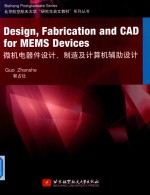图书介绍
微机电器件设计 制造及计算机辅助设计【2025|PDF|Epub|mobi|kindle电子书版本百度云盘下载】

- 郭占社编著 著
- 出版社: 北京:北京航空航天大学出版社
- ISBN:9787512421097
- 出版时间:2016
- 标注页数:272页
- 文件大小:36MB
- 文件页数:282页
- 主题词:微电子技术-高等学校-教材-英文
PDF下载
下载说明
微机电器件设计 制造及计算机辅助设计PDF格式电子书版下载
下载的文件为RAR压缩包。需要使用解压软件进行解压得到PDF格式图书。建议使用BT下载工具Free Download Manager进行下载,简称FDM(免费,没有广告,支持多平台)。本站资源全部打包为BT种子。所以需要使用专业的BT下载软件进行下载。如BitComet qBittorrent uTorrent等BT下载工具。迅雷目前由于本站不是热门资源。不推荐使用!后期资源热门了。安装了迅雷也可以迅雷进行下载!
(文件页数 要大于 标注页数,上中下等多册电子书除外)
注意:本站所有压缩包均有解压码: 点击下载压缩包解压工具
图书目录
Chapter 1 Introduction1
1.1 Concept of MEMS1
1.2 Development of MEMS4
1.3 MEMS CAD9
Chapter 2 Basic theory of MEMS12
2.1 Theory of electrostatic MEMS comb actuators12
2.1.1 Introduction12
2.1.2 Operating principles13
2.1.3 Plate capacitor theory in ideal condition14
2.1.4 The modified model of MEMS plate capaciator17
2.1.5 Calculation of electrostatic comb driving force in ideal situation24
2.1.6 Weak capacitance detection method of electrostatic comb drive26
2.2 Relevant theoretical calculations for the MEMS cantilever beam34
2.2.1 Introduction34
2.2.2 Theoretical calculation method for cantilever beam35
2.2.3 Relevant theoretical calculation of axial tensile and compressive on single-end clamped beams36
2.2.4 Related theoretical calculations of double-end clamped beams axial tension and compression40
2.3 Membrane theory of MEMS47
2.3.1 Theory of clamped around circular diaphragm48
2.3.2 Theory of clamped around rectangular flat diaphragm49
References52
Chapter 3 MEMS materials53
3.1 Monocrystalline silicon53
3.1.1 Introduction53
3.1.2 Crystal orientation of monocrystalline silicon55
3.2 Polycrystalline silicon64
3.3 Silica66
3.4 Piezoelectric materials67
3.4.1 Piezoelectric effect and inverse piezoelectric effect of materials67
3.4.2 Quartz crystal68
3.4.3 Piezoelectric ceramics73
3.5 Other MEMS materials75
3.6 Summary76
Chapter 4 MEMS technology77
4.1 MEMS lithography process78
4.2 Key technology of MEMS lithography process80
4.2.1 Wafer cleaning80
4.2.2 Silicon oxidation80
4.2.3 Spin coating process87
4.2.4 Prebaking90
4.2.5 Exposure92
4.2.6 Development94
4.2.7 Hardening96
4.2.8 Fabrication of the SiO2 window97
4.3 Subsequent process of MEMS98
4.3.1 Bulk silicon technology98
4.3.2 Surface silicon process103
4.3.3 LIGA technology104
4.3.4 Sputtering technology105
4.3.5 Lift-off process107
4.4 Film preparation technology107
4.5 Bonding process108
4.5.1 Anodic bonding process109
4.5.2 Silicon-silicon direct bonding110
4.5.3 Metal eutectic bonding113
4.5.4 Cold pressure welding bonding114
4.6 Engineering examples of combination for multiple processes to fabricate the MEMS device115
4.6.1 Introduction115
4.6.2 Engineering example of fabrication process for resonant MEMS gyroscope115
4.6.3 Engineering example of electromagnetic micro-motor production process118
4.7 Summary124
References125
Chapter 5 Friction wear and tear under micro scale126
5.1 Off-chip testing method for micro friction127
5.1.1 Micro-tribology test with the pin-on-disc measuring method127
5.1.2 Micro-tribology test with AFM128
5.1.3 Micro-tribology test with special measuring device130
5.2 On-chip testing method for micro friction132
5.2.1 On-chip testing method actuated by electrostatic force132
5.2.2 On-chip micro-friction testing method using the mechanism characters of the bimorph material139
5.3 Example of the design for an on-chip micro-friction structure141
5.3.1 Structure and working principle141
5.3.2 Calculation of pertinent theory142
5.3.3 Technological analysis of structural design148
5.3.4 Testing results and data analysis152
5.3.5 Research and test of wear problem of MEMS devices161
5.4 Summary165
References165
Chapter 6 MEMS testing technology and engineering application169
6.1 Acceleration measurement and corresponding sensors169
6.1.1 Working principle of the acceleration sensor and the classification170
6.1.2 Capacitive silicon micromechanical accelerometer172
6.1.3 Piezoresistive silicon micromechanical aceelerometer173
6.1.4 Piezoelectric micromechanical accelerometer174
6.1.5 Resonant silicon MEMS accelerometer175
6.2 Angular speed measurement and corresponding sensors177
6.2.1 Working principle177
6.2.2 Development of MEMS gyroscope178
6.2.3 Classification of micromechanical gyroscope188
6.3 Pressure measurement and corresponding sensors190
6.3.1 Working pincinple190
6.3.2 Resonant silicon micromechanical pressure sensor and its development193
6.4 Measurement of micro-torque198
6.4.1 Introduction198
6.4.2 Working principle of noncontact method199
6.4.3 Theoretical calculation200
6.4.4 Corresponding equipment to realize the noncontact method205
6.4.5 Experiment result and discussion209
6.5 Microscopic morphology testing method211
6.6 Summary212
References212
Chapter 7 Application examples of the finite element method in the design of MEMS devices218
7.1 Important concepts of the software218
7.2 Introduction of the Ansys software interface220
7.3 The coordinate system in Ansys221
7.4 Engineering examples226
7.4.1 Static analysis of single-clamped beam226
7.4.2 Modal analysis of double-clamped beam245
7.4.3 Capacitance analysis of MEMS electrostatic comb fingers drive257
7.4.4 Fatigue strength calculation example264
7.5 Summary272
热门推荐
- 3697822.html
- 3697603.html
- 1378145.html
- 3541044.html
- 3101936.html
- 3411860.html
- 2301930.html
- 2031769.html
- 2023358.html
- 1642607.html
- http://www.ickdjs.cc/book_2124788.html
- http://www.ickdjs.cc/book_982532.html
- http://www.ickdjs.cc/book_3764597.html
- http://www.ickdjs.cc/book_311552.html
- http://www.ickdjs.cc/book_2121840.html
- http://www.ickdjs.cc/book_1850248.html
- http://www.ickdjs.cc/book_2494800.html
- http://www.ickdjs.cc/book_3407901.html
- http://www.ickdjs.cc/book_2740799.html
- http://www.ickdjs.cc/book_3109547.html